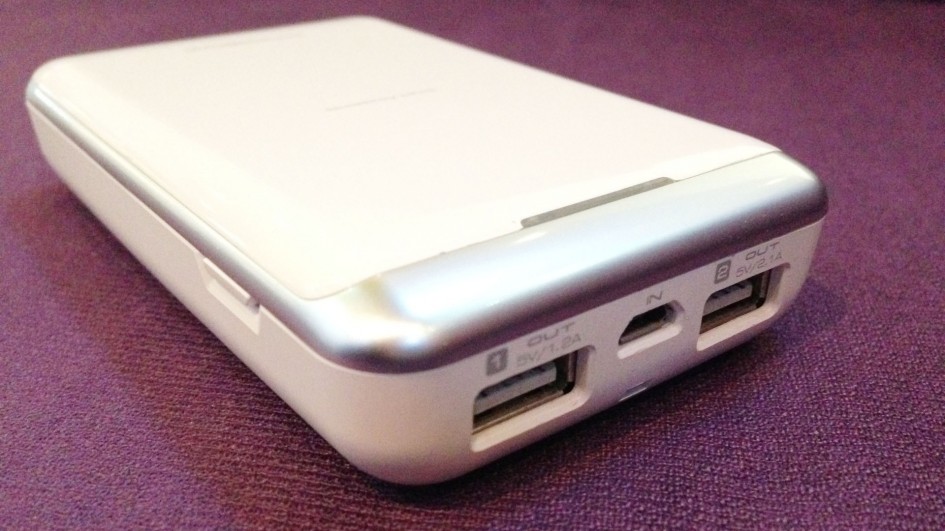Ever wondered why your 4,000mAh may not even charge your 1,570mAh iPhone 5S twice? Here’s why: –
Devices consume power (“P”) and that is measured in watts. To derive watts, we need to multiply the amperage (“I”) by voltage (“V”).
P = I x V
* Also note: 1A = 1,000mA
The 4,000mAh rating of the power bank refers to the charge capacity of Lithium-ion cells in the power bank, and that is different from what comes out of the USB port because both operate at different voltages.
Lithium-ion batteries operate between 3.2-4.2V (stable at 3.7V) while USB devices operate at 5V.
This means that: –
- The power bank can only deliver 4Ah x 3.7V = 14.8Wh
- It will only charge a 5V USB device to 14.8Wh / 5V = 2.96Ah or 2,960Ah
Now, you must be thinking: “Hey, my phone also uses a lithium-ion cell, so it should convert (back) to the same”.
It is partially correct to assume that, but power reduction process will likely result in losses (usually in the form of heat) so it is not a 100% efficient process.
The power bank itself would also be stepping down (or stepping up, depending on design) its voltage. If it’s cells are wired in 2 series, it would need to step down from 3.7V x 2 = 7.4V to the USB output voltage of 5V before you can use it to charge your phone.
With two devices stepping down power (Power bank > USB > Phone > Phone Battery) the efficiency can be as low as 64% (80% x 80%).
So as an example, to charge a 1,570mAh battery in the iPhone 5S, we will need a constant 1.57A x 4.2V (charging voltage of li-ion) = 6.594 watts.
Assuming both the power bank and phone are only 80% efficient at converting the power, this would mean that the power bank must deliver at least:
6.594W x 1/(0.8 x 0.8) = 10.3W
10.3W / 3.7V = 2,784mAh power bank is required to charge an iPhone 5S
Also remember that while charging your phone, the phone is likely to consume some power during the process even if it is completely powered off because it has to regulate the charging process, alternating between charging and measuring the charge state of the battery. This is required to protect the battery in your phone from over-charging.
Another thing to know about is charge rate (“C”). The higher the charge rate, the faster it charges. At 1C, a battery will be fully charged in an hour. At 2C, it will be charged in half an hour.
Most phones are designed to charge between 0.5C to 1C to ensure maximum lifespan of the battery. This means it will take between 1 to 2 hours to charge. Charging lithium-ion batteries above 1C may shorten its lifespan (and that’s why you should not use cheap docking chargers or avoid “quick” chargers.)
Why should you care since the phone is already regulating the charge rate for you? That’s because the charge rate affects the current draw on the power bank.
If a 4,000mAh power bank claims to provide a 1A USB charging port, it means it should deliver 1A x 5V = 10W of power constantly.
To charge an iPhone 5S @ 1C would require at least 1.57A x 4.2V = 6.59W (before efficiency losses). If we factor in efficiency losses @ 80% for both the power bank and the phone then 6.59W / (0.8 x 0.8) = 10.3W. That’s approximately 1A!
For a bigger device like a Samsung Note 3 with a 3,200mAh battery, it is likely to be charged at 0.5C. Quick calculation yields (3.2A x 4.2V x 0.5C) / (0.8 x 0.8) = 10.5W which is also just above 1A.
As you can see most devices require around 1A to charge, but if you are going to be using your phone while charging then the current draw may well exceed 1A and you will need a power bank capable of delivering more. If you use an underrated power bank you may damage (overheat) its internal voltage regulators.
Lastly, if you are charging your phone, try not to use it at the same time as doing so might also put too much current through the phone’s voltage regulator causing it to fail prematurely. This is especially common on bigger phones. If you feel your phone getting hot, it’s a sign to stop. Depending on phone design, you may have to change the entire logic board.
